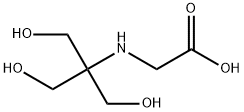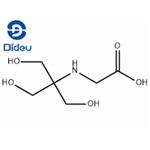Tricine is a zwitterionic amino acid. It is a white crystalline powder. It was first prepared by Good to buffer chloroplast reaction.1 Tricine is a commonly used electrophoresis buffer and is also used in resuspension of cell pellets.1,2 Attributing to its higher negative charge than glycine, it can migrate faster. At the same time, its high ionic strength results in more ion movement and less protein movement. Therefore, it works as a buffer component for separation of low molecular weight peptides.3
- S. R. Haider, B. L. Sharp, H. J. Reid, A comparison of Tris‐glycine and Tris‐tricine buffers for the electrophoretic separation of major serum proteins, Journal of Separation Science, 2011, vol. 34, pp. 2463-2467
- H. Schägger, G. von Jagow, Tricine-sodium dodecyl sulfate-polyacrylamide gel electrophoresis for the separation of proteins in the range from 1 to 100 kDa, Analytical Biochemistry, 1987, vol. 166, pp. 368-379
White/clear crystalline powder
Good's buffers Tricine is used as an electrophoresis buffer and involved in the separation of low molecular weight proteins and peptides. It operates in the pH range between 7.4 and 8.8. It acts as an effective scavenger of hydroxyl radicals during the study of radiation-induced membrane damage. It is also used in resuspension of cell pellets. It is a zwitterionic amino acid commonly useful in the pH range of 7.4-8.8 and the pKa is 8.05 at 25°C. This buffer is also used as an eluent in asymmetrical flow field-flow fractionation (AFFFF).
ChEBI: N-tris(hydroxymethyl)methylglycine is a Good's buffer substance, pKa = 8.15 at 20 ℃. It is functionally related to a member of tris and a glycine. It is a tautomer of a N-tris(hydroxymethyl)methylammonioacetate.
Tricine and its salts are used as biological buffers to control the pH of body fluids in vitro and in vivo. It acts as a precursor for polymers, oxazolones (with carboxylic acids), and oxazolidines (with aldehydes). Trizma can serve as an alkalizing agent in treating acidosis of the blood.
Electrophoresis buffer. Working pH range: 7.4 - 8.8. Commonly used in SDS-PAGE to seperate peptides. Also used in other electrophoresis methods, high performance liquid chromatography and ion exchange chromatopgraphy.
Crystallise Tricine from EtOH and water. [Good et al. Methods Enzymol 24B 53 1968, McGothlin & Jordan Analyt Lett 9 245 1976, Beilstein 18 III/IV 3454.]



